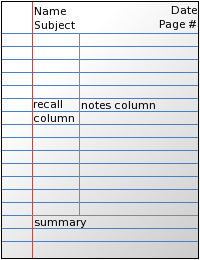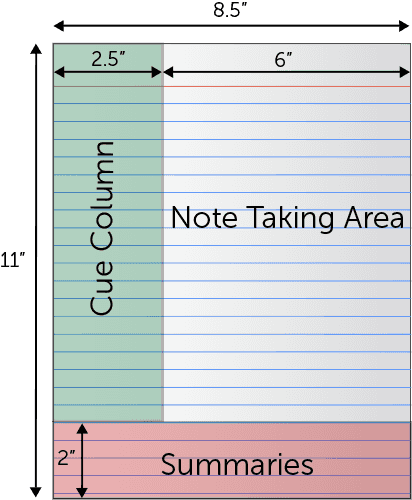H
Haseung Jun
H
Haseung Jun
Productivity ⏰
44 resourcesSee Units
How to Increase your Learning with Cornell Notes
How they came to be
The Cornell method of note-taking was invented in the 1950s by an education professor named Walter Paul 👨🎓, who worked at the method's namesake of Cornell University. He later advocated this strategy through his book How to Study in College, which made this skill well-known worldwide!🤩
How to use it
Though technically a 5-step process 5️⃣, there’s a lot of liberty regarding note-taking, so don’t feel pressured to complete Cornell notes this way✨. Remember that these are your notes and your notes only, so do whichever steps are best for your learning. We call these steps the 5 Rs of Cornell Notes:🎈
- Record: First, take regular notes during the lecture 🤓. These should be traditional, bullet point notes. 🙈
- Review: After writing your notes, write some keywords and questions in the left column. On the bottom of the page, write out the summary of whatever you learned 🙌, including core concepts 🎆 and vocabulary words 🎫. This section can also include diagrams🎨, which should help your eyes take in information a lot quicker!
- Recite: Cover up your notes and try to define🧐 the keywords and answer the questions you wrote previously. If possible, you should complete this process out loud.🗣
- Reflect: After step 3, ask yourself where your weaknesses are and highlight 👀 them so you know that you should pay closer attention to these highlighted concepts when studying for your test 🙊.
- Review: Ideally, before the test, look over your notes. Since the Cornell method requires a lot of organization, you’ll be able to navigate through them quickly. Look at what you wrote, especially the highlighted sections 💡, to maximize your studying! Also, be sure to check out the Pomodoro Method when studying. 📑
What it looks like
Here’s what your notes should look like if you’re using the Cornell Notes method:

Image courtesy of Thinking Insights
First, you should draw a big "I" to divide your page and title your notes. Next, you should write any important questions, comments, and keywords on the leftmost column and your regular, traditional notes in the larger column 🧾. Be sure to leave around two inches worth of space for a summary 📚 of all the content you covered on this page at the end. Here's an image to help you visualize how your notes should look using the Cornell method:

Image courtesy of Wikipedia

Image courtesy of University of Maine at Fort Kent
Why you should use it
Cornell notes are not most people's preferred way of taking notes, as they have a bad reputation. In middle and high school, many teachers 👨🏫 required students to use this intricate notetaking method, reviewed them for a grade, and docked off points for criteria like organization. There's no wonder why so many people despise Cornell notes 😡. In reality, however, they're not that terrible. Cornell notes efficiently organize key points and questions for lectures, allow for in-depth notes and commentary 📄, and provide broad overviews of a lesson with a summary section.
Nowadays, many students use computers to type up their notes because it's so efficient; typing is much faster than writing by hand ✍. Taking notes the old-fashioned way, though, has an advantage. When we write by hand, our brain 🧠 remembers the content we wrote more than we would by typing because of the amount of energy it took.
The organizational aspect of Cornell notes is another advantage that can't be ignored by those who type their notes 📌. Because they are organized neatly, they're easier to read 📖and remember than a Google Doc jam-packed with size 12 text!
Other thoughts
Alrighty, so we’ve gone through all of the Cornell Notes, but just be aware that Cornell Notes If you like your study materials to be neat and concise 📚 while still being informative🖍, Cornell notes may be for you! Know that Cornell notes do take a long time to write and format, but in the end, they're incredibly effective studying tools 🔋.
If the Cornell method of notetaking doesn't work for you, there are many other ways 📒 to take notes, so don't worry! It's best to customize your notes to fit your learning style and thinking process 📋, and Cornell notes are not one size fits all. 📁
...and that's about it! While notes can be boring at times, they only help you do better on your assignments, so be sure to try out Cornell notes! ✨
Connect with other students studying with Hours
Browse Study Guides By Unit

© 2025 Fiveable Inc. All rights reserved.